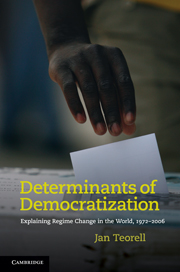Book contents
- Frontmatter
- Contents
- List of tables
- List of figures
- Acknowledgments
- Introduction
- 1 Explaining democratization
- 2 The shadow of the past: social determinants
- 3 The power of prosperity: economic determinants
- 4 The impetus from abroad: international determinants
- 5 The force from below: popular mobilization
- 6 Exogenous shocks and authoritarian regime types: institutional contingency
- 7 Conclusions
- Appendix A Data and variable definitions
- Appendix B Statistical model
- Appendix C Robustness tests
- Appendix D The pathway criterion
- References
- Index
Appendix A - Data and variable definitions
Published online by Cambridge University Press: 05 June 2012
- Frontmatter
- Contents
- List of tables
- List of figures
- Acknowledgments
- Introduction
- 1 Explaining democratization
- 2 The shadow of the past: social determinants
- 3 The power of prosperity: economic determinants
- 4 The impetus from abroad: international determinants
- 5 The force from below: popular mobilization
- 6 Exogenous shocks and authoritarian regime types: institutional contingency
- 7 Conclusions
- Appendix A Data and variable definitions
- Appendix B Statistical model
- Appendix C Robustness tests
- Appendix D The pathway criterion
- References
- Index
Summary
The large-n analysis of this study is based on a cross-sectional time-series database covering 196 countries in the world from 1972 to 2006. They include all countries in the world recognized by the United Nations during this time period, plus Taiwan, but excluding countries having fewer than 100,000 inhabitants and no statistical data on GDP in the World Bank World Development Indicators (leaving out Andorra, Liechtenstein, Monaco, Nauru, San Marino and Tuvalu). With respect to countries that have merged or split during the period of observation, I follow the standards applied in Teorell et al. (2009). With respect to countries that have split, this means I treat Ethiopia as a distinct case after the secession of Eritrea, Russia as distinct from the USSR, Serbia-Montenegro as distinct from the People’s Republic of Yugoslavia, and the Czech and Slovak Republics from Czechoslovakia. (I do, however, treat Indonesia as the same case before and after the secession of Timor-Leste.)
Due to missing data, however, the most general estimation sample used throughout this book (except in the multiple imputation model 7 in Table C.1) consists of 165 countries. The following thirty-one countries are not included in the estimation sample: Afghanistan, Cuba, Czechoslovakia, Equatorial Guinea, Ethiopia before the secession of Eritrea in 1993, East and West Germany, Iraq, Kiribati, North Korea, Laos, Libya, Marshall Islands, Mauritania, Micronesia, Myanmar, Palau, Sao Tome and Principe, Serbia and Montenegro, Somalia, Taiwan, Timor-Leste, North and South Vietnam, USSR, Uzbekistan, Vanuatu, North and South Yemen, the Republic of Yemen, and the People’s Republic of Yugoslavia.
- Type
- Chapter
- Information
- Determinants of DemocratizationExplaining Regime Change in the World, 1972–2006, pp. 161 - 170Publisher: Cambridge University PressPrint publication year: 2010

